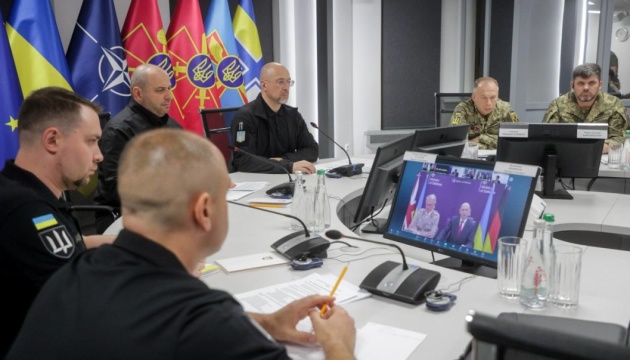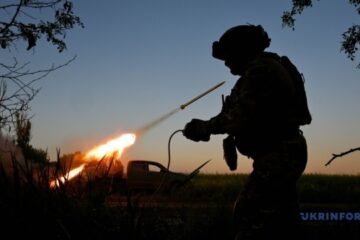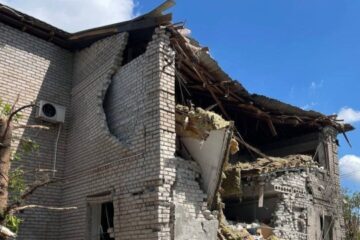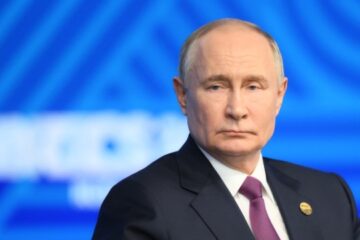
The 29th meeting of the 50-nation strong Ukraine Defence Contact Group (UDCG, otherwise known as Ramstein Group) passed without loud statements, but with important changes: the coalition of partners is moving on to a model of long-term war planning
On July 21, Ukraine’s Western allies came together for yet another – the twenty-ninth – meeting of the Ukraine Defense Contact Group in the “Ramstein” format, which was held online under the shared chairmanship of Great Britain and Germany. It was attended by defense ministers from 52 countries. The State of Ukraine was represented by the newly appointed Minister of Defense Denys Shmyhal and former Minister of Defense Rustem Umerov – that time around in the status of Secretary of the National Security and Defense Council.
Ahead of the event, Kyiv, through the Commander-in-Chief of the Armed Forces of Ukraine Oleksandr Syrsky, traditionally announced its requirements that are vital for continuing its liberation war against Russia — additional air defense systems and related missiles, long-range weaponry, artillery ammunition, armored vehicles, electronic warfare systems, radars, and a variety of drone platforms among other things.
Were our needs met?
Judging by an encouraging reaction from Mr. Shmyhal, everything went well: “The free world stands with Ukraine and peace. Together with our partners, we focused on strengthening the defense potential of the Ukrainian army,” Shmyhal said in an official statement.
Key statements respond to emerging military reality
The discussion at the most recent Ramstein Group meeting unfolded along two parallel lines. The first was political and diplomatic, set by UK Defense Secretary John Healy. His call for a “50-day arms surge” became the main refrain of the day. His explicit and mobilizing rhetoric was designed to demonstrate unity and determination. Healey emphasized the need for the West to significantly increase military support for Ukraine, assuring that the UK will “play [its] full part in its success to bolster Ukraine’s immediate fight.” “As members of the Ukraine Defense Contact Group, we need to step up in turn with a ‘50-day drive’ to arm Ukraine on the battlefield and force Putin to the negotiating table,” Mr. Healy said.
The European partners essentially have accepted the rules of the game proposed by Trump and are now trying to prove their effectiveness in the new conditions.
The other line – the military-pragmatic one – was outlined by Healey’s German counterpart Boris Pistorius. His speech came as cold shower to those who could have taken Trump’s ultimatum to Putin as a real possibility of a soon coming peace. Pistorius spoke out in harsh terms: “Putin has no real interest in meaningful peace talks.” He painted a picture of the Kremlin’s cynical game, where talks about peace are just a cover for amassing forces and continuing terror. “Putin, with grim determination, is pushing his military agenda and is not interested in negotiations. In the morning he talks about peace, but by evening he launches missiles at Ukrainian civilians. He wants to buy time with this cynical game,” the German minister noted with irony bordering on fatigue. His speech was devoid of unnecessary diplomatic euphemisms: the Russian war machine can only be stopped by force, and the main priority is in the immediate and massive strengthening of Ukraine’s air defense capabilities.
Against the backdrop of this dialogue of giants, Ukraine’s position sounded as substantial as possible. For Denys Shmyhal, the newly appointed Minister of Defense, the meeting was a baptism of fire. He immediately translated the conversation into numbers, announcing the urgent need for $6 billion to cover this year’s defense procurement gap. This amount became a kind of test of the new aid system’s capacity. Shmyhal clearly articulated what these funds are needed for: drones for defense, drone interceptors to protect cities and civilian infrastructures, and, most importantly, “additional deep-strike armaments to return the war to Russia.” This statement signifies a transition from a purely defensive to a proactive strategy of exhausting the enemy on its territory. At the same time, Rustem Umerov, summing up his work at the head of the Ministry of Defense, highlighted Ukraine’s evolution from a passive recipient to a full-fledged industrial partner. The figures about 40% of the battlefield requirement being covered by domestic industries and 95% of drones of Ukrainian origin are not just statistics. This is an argument in favor of investment. Umerov’s message is simple: by helping the Ukrainian defense industry, partners are investing not in a bottomless pit, but in an asset that has already proven its effectiveness and is capable of bolstering common security in the future.
Specifics of aid – air defenses, drones and a new financial model
An analysis of the announced packages suggests that not only the allies have heard Ukraine’s requests, but also formulated a comprehensive, multilayered response aimed at accomplishing key objectives.
The new funding architecture is undoubtedly the main result of Rammstein-29. The United States, while distancing itself from providing the funding directly, is initiating a new mechanism in cooperation with NATO, allowing European countries to procure American weaponry for Ukraine. This simple and effective move by the Trump administration allows the United States to maintain the status of the “arsenal of democracy”, while shifting the role of the “purse of democracy” to the shoulders of Europe. The NATO Security Assistance and Training for Ukraine (NSATU), headquartered in Wiesbaden, Germany, is turning into a key logistical and financial hub. The success of Ukraine’s support will now depend directly on how quickly and generously European capitals will fill this mechanism with real money.
Fortress in the sky is the second key priority. The response to Russia’s terror came immediately. The agreement reached between Germany and the United States to provide Ukraine with five Patriot air defense systems is an unprecedented step, demonstrating an awareness of Ukraine’s critical vulnerability to Russian air attacks. This flagship project is complemented by air defense “workhorses”: 220,000 rounds of ammunition for the German-supplied Gepard air-defense platforms, to be procured by Germany and delivered in cooperation with Great Britain, as well as contributions from Belgium, Sweden, Norway and the Netherlands.
On top of that, the Danish company Terma is forming a partnership with Ukraine’s Odd Systems to develop an affordable drone interception system capable of identifying, tracking, and autonomously neutralizing a wide range of air threats, from FPV drones and Mavic-type quadcopters to reconnaissance and long-range UAVs. Thus, a multilayered air defense shield is being created, designed to secure the skies over critical facilities.
Asymmetric response and strategic depth are the third dimension of assistance. While air defenses are a shield, then drones and long-range weapons are a sword. And here a revolutionary shift has got underway. Leading nations are starting to invest not only in the delivery of their own systems, but also in the production of Ukrainian ones. Germany’s decision to fund procurements of long-range drones manufactured in Ukraine is a powerful signal of confidence in Ukrainian technology. The first procured systems, which will arrive “within a few days,” will be proof that this mechanism works. Norway is reinforcing this trend further by allocating €400 million from its billion-dollar drone package to fund direct contracts with Ukrainian companies. This creates a synergistic effect: Ukraine receives the necessary weaponry to engage targets far behind enemy lines, its economy is a powerful incentive, and Russia gets a clear signal that retribution for aggression is inevitable.
The following is a summary of the key decisions made at the 29th meeting of the Ukraine Defense Contact Group:
The United States announced the launch of a new mechanism in cooperation with NATO, enabling European countries to procure American weapons for Ukraine.
The UK and Germany announced a new agreement to partner in providing critical air defense ammunition to Ukraine. Germany will provide more than 170 million Euros worth of funding, which the UK will use to rapidly procure air defense ammunition via the UK-led International Fund for Ukraine for delivery in the coming months. This supports the aims of the Integrated Air and Missile Defense Capability Coalition, co-led by Germany and France.
Germany will join the US-led initiative to provide Ukraine with five Patriot air defense systems, expected to arrive soon. In addition, Berlin will transfer over 200,000 rounds for Gepard air-defense platforms and fund the procurement of Ukrainian-manufactured long-range drones.
Canada confirmed its participation in the so-called Danish model to support Ukraine’s defense industry, allocating around $14.6 million to maintain Ukrainian tanks.
The Netherlands committed $218 million for drone interceptors and $136 million for F-16 maintenance.
Norway announced a $1.09 billion drone procurement program for 2025, of which $436 million will go toward purchasing drones from Ukrainian manufacturers.
Sweden is compiling a new aid package comprised of air defense equipment, artillery, and other military hardware.
These important elements complement the overall picture and fill critical capability gaps.
Conclusion notes
The 29th meeting of the Ukraine Defense Contact Group marked the end to the era of centralized support and the beginning of a new, more complex and mature phase based on the principle of distributed responsibility. For Ukraine, this means the need to work even more closely and professionally with European capitals, proving the effectiveness of each investment made. For Europe, this is a historic chance and at the same time a test of strategic capability.
The decisions made, provided they are quickly implemented, can give a significant boost to Ukraine’s defense industrial capacity growth at this critical juncture. The emerging aid architecture, while being more difficult to manage, lays the foundation for more sustainable and long-term support. Ramstein-29 has demonstrated that the free world is ready not only to respond to challenges, but to rebuild its own structures for the common goal of ensuring a just peace through the strength and resilience of Ukraine, which is increasingly establishing itself as an indispensable pillar of European security.
Myroslav Liskovych. Kyiv
Source: Arm Ukraine over 50 days. Key outcomes of the 29th UDCG meeting



